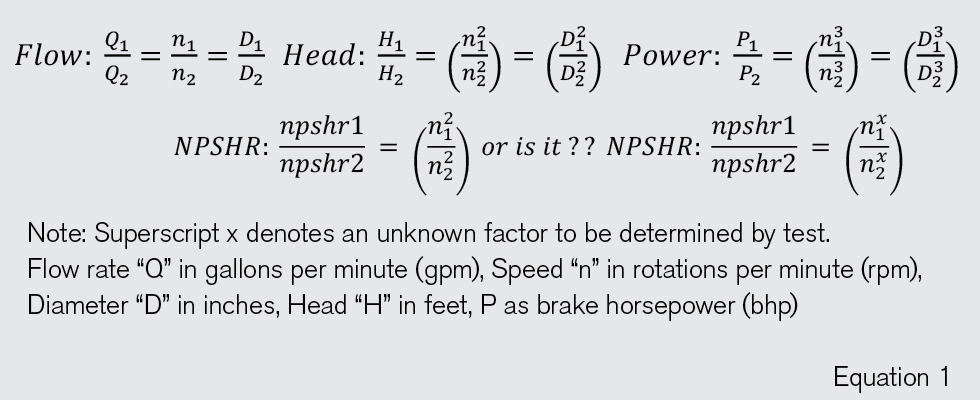
Scalability
Scalability is a buzzword you will hear tossed around in the computer software and high-tech business worlds, but it is important to know that not all things will scale successfully. If you have ever baked bread and wanted to increase production, you will quickly learn that simply doubling the recipe will yield poor results. Based on a given recipe, you are better off baking two loaves of bread than trying to make one loaf twice the size. Hint: It’s the yeast. You may also add computer software and nuclear reactor core designs to a long list of things that don’t scale well, though yeast is not involved.
The purpose of this column is to add one more item to the list of things that do not scale well. With respect to the affinity laws, most readers would concede that net positive suction head required (NPSHr) will change with the speed ratio squared, while in reality that is not true. The speed ratio exponent is also commonly referred to as the affinity exponent.
Affinity Laws
For over 120 years, the affinity laws have been utilized to accurately scale pump performance to determine head, flow and power changes with corresponding variations in speed and/or impeller diameter. This is a very handy tool when dealing with today’s variable frequency/speed drives. The affinity laws also work for fans and hydraulic turbines.
The laws simply state: The flow rate changes directly as the speed or impeller diameter ratio, and the developed head changes as the speed or diameter ratio squared. Power changes as the speed ratio cubed. Efficiency remains approximately the same for minor changes. For making diameter changes, the speed remains constant, and for speed changes, the diameter remains constant.
It is important to understand that while we refer to these rules as the affinity laws, in practice, the regimented rules of geometric scaling and similitude are rarely followed, so there will be expected errors in real-world applications.
Equations
The laws for diameter changes are limit dependent. As a caveat, note that impeller diameter changes require some modification of the affinity laws as you approach the defined minimum diameter, but those changes also have established correction factors (more on this later). Further, these rules hold their accuracy fairly well for radial impellers but start to deteriorate as specific speed (Ns) increases.
As mentioned above, the affinity laws have limits as to accuracy and validity, and the best reminder is the dictum, “the pump will operate where the system dictates.” That is, the pump will operate where its performance curve intersects with the system curve if possible.

Pump Performance Testing
Testing pumps for head and flow are fairly straightforward evolutions that require minimal instrumentation and interpretation. Testing for power and efficiency are also straightforward exercises when using the proper metrology. Reliable manufacturers will ensure that the calibrated test instruments and data are both accurate and valid. There is little need to be concerned with deviation, instrumentation uncertainty and measurement uncertainty.
On the other hand, testing for NPSHr is a difficult evolution that requires data/parameters collected from at least six or seven different instruments in addition to an accurate and simultaneous determination of net positive suction head available (NPSHa). This is not an easy task in and of itself.
Consequently, there is a higher probability that the instruments and test results for NPSHr are subject to some small error and interpretation leading to instrumentation and measurement uncertainty. I realize this subject path digresses into a complicated subject and suggest it is better explained in Hydraulic Institute Standard 14.6, the American Society of Mechanical Engineers (ASME) PTC 19.1-2005 and ASME PTC 8.2-1990.
Summarily, there is a small level of uncertainty in the results that is recognized and acknowledged by the industry governing standards. This conundrum is not unique to any individual manufacturer, and the degree of uncertainty is shared by all pump manufacturers in their testing. Please understand these are systemic errors and not human errors.
Testing for NPSHr is a sensitive and demanding process. Air entrainment in the water, even at the small amount of 1%, will affect the accuracy. The liquid velocity profile (think Reynolds number) as it enters the pump suction nozzle in its final approach to the impeller eye must be both uniform and laminar in three planes. The materials of construction and the surface finish of the impeller in conjunction with the casing/volute inlet passages will also have measurable effects on the test outcome. Even the Newtonian properties, specific gravity and viscosity of the liquid will come into play. I call this the liquid personality quotient.
Heavy Burden
When a manufacturer tests a pump for the purpose of generating a published performance curve (also known as a price book or published curve), they initially test the pump at the designed impeller diameter and speed. The data points for head, flow, efficiency, power and NPSHr are collected, documented and calculated. All other data for the establishment of alternative performance curves at other speeds and diameters are extrapolated/calculated using the affinity laws for the allowed operating region. This practice is an acceptable method used by pump manufacturers and is endorsed by the Hydraulic Institute, ASME and the Department of Energy to “remove the heavy burden” of testing at all points for all pump sizes and models.
It is also important to know that, as an industry best practice, most manufacturers will conduct additional tests (different diameters and speeds) to establish higher levels of performance curve veracity. The validation process pertains to the entire allowable operating region. I strongly recommend expanding the testing for NPSHr at different speeds with the same impeller to establish the correct affinity exponent properly and accurately, otherwise the published NPSHr curves will be erroneous. You should also test for NPSHr at different diameters.
Over time, and in the spirit of continuous improvement, the manufacturer will continue testing the pump and collecting sustaining data for other reasons, such as whenever a customer requests a performance test. Prudent manufacturers will continue to check and document performance on a regular schedule and/or as casting patterns/processes and/or foundries change. This quality process continues for the commercial life of the pump because it is considered a best practice for the conscientious manufacturer to continually populate and validate the pump’s performance matrix.
NPSHr Doesn’t Play by the Rules
As previously mentioned, while NPSHr is often purported to change with the speed ratio squared, actual tests show that the calculated results are not always accurate using this exponent (2).
Industry tests have found the NSPHr affinity exponent is not a constant and will change depending on the impeller’s overall geometry, which can be described by its specific speed, and even more importantly, the impeller’s inlet geometry described by its suction specific speed (Nss).
Just to make the NPSHr testing issue even more difficult, the exponent is not constant, even within a given model, because it will vary dependent on whether the pump speed is being adjusted up or down. To a lesser extent, the exponent will also vary with the liquid properties. For example, hydrocarbons will typically have a lower exponent than caustics. The exponent will also change relative to the operating position on the curve measured as the percent of departure (plus or minus) from the best efficiency point (volume flow rate as % of QBEP). For pump impellers with Ns below 6,000 United States Customary (USC) units (120 Systems Internation [SI] units), the affinity exponent can range from a low of 1.3 to a high of 2.2 but will typically range from 1.6 to 2.0. Normally, the exponent is higher when increasing the speed of the pump and vice versa. Stated another way, using the commonly accepted exponent of 2 will overpredict NPSHr when you are increasing speed and will underpredict when decreasing speed.
To the best of my knowledge, commercial pump performance software providers depend on input from the manufacturer for the affinity exponent and do not unilaterally determine or assume the value. From an intellectual property aspect, most pump manufacturers do not externally share their collected data regarding the NPSHr affinity exponent.
Summary Comments
It is important to test for NPSHr if the predicted NPSH margin is low.
When using the NPSHr affinity rules, realize the exponent is probably not 2. When using the NPSHr affinity rules, realize the exponent is not a constant value. Scaling up or down in speed makes a difference in the NSPHr exponent value.
Efficiency remains approximately the same for minor changes in speed and/or diameter, but I highly recommend you check/test or you could undersize the driver.
You can use the affinity laws to confidently predict small to moderate changes in pump performance but not how the pump interacts with the system. One of the potential issues is that neither the system static head nor the system pressure head changes with pump speed or impeller diameter. Your system may not have static and/or pressure head as a system curve component, but the other factor that may not be changing is the system pipe diameter, which translates as the friction head. You must therefore calculate the new system curve to accurately predict where the revised pump will operate.
Using the affinity laws to make impeller diameter changes can often lead to expensive mistakes. When decreasing the diameter by 1% to 8% from the maximum (design), the calculations will be close. As you remove more material, the accuracy falls off. The main issue is that the casing/volute remains the same diameter as you reduce the impeller diameter, so the more you trim, the less accurate the affinity law relationship. (Note that this discrepancy ties to my earlier comment regarding geometric scale and similitude.) I always recommend checking with the manufacturer and/or completing the trim in multiple steps with a performance check in between.
As I state in my pump classes, “it is really easy to take the metal off of the impeller, but it is really hard to put it back.” When trimming more than 25% to 30% from the maximum diameter, the affinity rules become very inaccurate. I would limit trimming to no more than 20% of the maximum impeller size (leaves 80% of the original impeller). Trimming more than 30% is usually an ineffective practice and indicates the pump is not a good match to the system (I am sure there are exceptions and commercially inspired compromises).
My comments on impeller trimming are for single stage pumps of moderate to low specific speeds. Multistage pumps are a little bit trickier, because while trimming the impeller for dynamic head changes you can, under the law of unintended consequences, also reduce the flow rate and efficiency more than you calculated. Please check with the manufacturer before you make diameter changes.
The impeller diameter stamped on the pump nameplate was probably correct when it left the factory, but ask yourself: How many times has someone else worked on the pump?
One last bonus tip: Like NPSHr, power (bhp) doesn’t exactly play by the affinity rules either. Actual field tests will yield an affinity exponent close to 3, but not quite.
References
- Centrifugal Pumps (2nd edition) Johann Friedrich Gulich
- Centrifugal Pumps; Selection, Operation and Maint. Igor Karassik and Terry McGuire
- The Pump Handbook (4th edition) Dr. Paul Cooper, et. al.
- ASHRAE Journal Vol 53 Issue 3, March 2011, Richard Ford
- Sulzer Pumps Centrifugal Pump Handbook (2nd edition)
- BWR Owner’s Group, BWROG-TP-12-011/-014 Rev 0, August 2012


